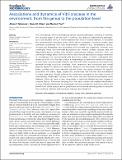Associations and dynamics of Vibrionaceae in the environment, from the genus to the population level
Author(s)
Chien, Diana M.; Takemura, Alison Francesca; Polz, Martin F
DownloadTakemura-2014-Associations and dynamics.pdf (1.944Mb)
PUBLISHER_POLICY
Publisher Policy
Article is made available in accordance with the publisher's policy and may be subject to US copyright law. Please refer to the publisher's site for terms of use.
Terms of use
Metadata
Show full item recordAbstract
The Vibrionaceae, which encompasses several potential pathogens, including V. cholerae, the causative agent of cholera, and V. vulnificus, the deadliest seafood-borne pathogen, are a well-studied family of marine bacteria that thrive in diverse habitats. To elucidate the environmental conditions under which vibrios proliferate, numerous studies have examined correlations with bulk environmental variables—e.g., temperature, salinity, nitrogen, and phosphate—and association with potential host organisms. However, how meaningful these environmental associations are remains unclear because data are fragmented across studies with variable sampling and analysis methods. Here, we synthesize findings about Vibrio correlations and physical associations using a framework of increasingly fine environmental and taxonomic scales, to better understand their dynamics in the wild. We first conduct a meta-analysis to determine trends with respect to bulk water environmental variables, and find that while temperature and salinity are generally strongly predictive correlates, other parameters are inconsistent and overall patterns depend on taxonomic resolution. Based on the hypothesis that dynamics may better correlate with more narrowly defined niches, we review evidence for specific association with plants, algae, zooplankton, and animals. We find that Vibrio are attached to many organisms, though evidence for enrichment compared to the water column is often lacking. Additionally, contrary to the notion that they flourish predominantly while attached, Vibrio can have, at least temporarily, a free-living lifestyle and even engage in massive blooms. Fine-scale sampling from the water column has enabled identification of such lifestyle preferences for ecologically cohesive populations, and future efforts will benefit from similar analysis at fine genetic and environmental sampling scales to describe the conditions, habitats, and resources shaping Vibrio dynamics.
Date issued
2014-02Department
Massachusetts Institute of Technology. Department of Biology; Massachusetts Institute of Technology. Department of Civil and Environmental Engineering; Parsons Laboratory for Environmental Science and Engineering (Massachusetts Institute of Technology)Journal
Frontiers in Microbiology
Publisher
Frontiers Research Foundation
Citation
Takemura, Alison F., Diana M. Chien, and Martin F. Polz. “Associations and Dynamics of Vibrionaceae in the Environment, from the Genus to the Population Level.” Frontiers in Microbiology 5 (2014).
Version: Final published version
ISSN
1664-302X